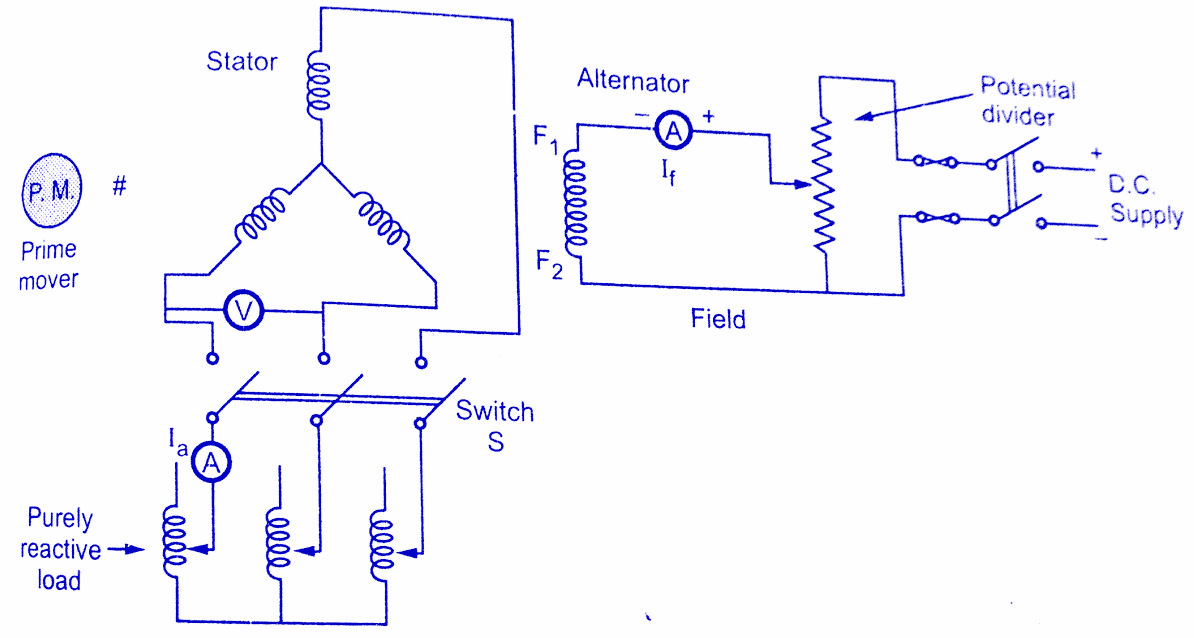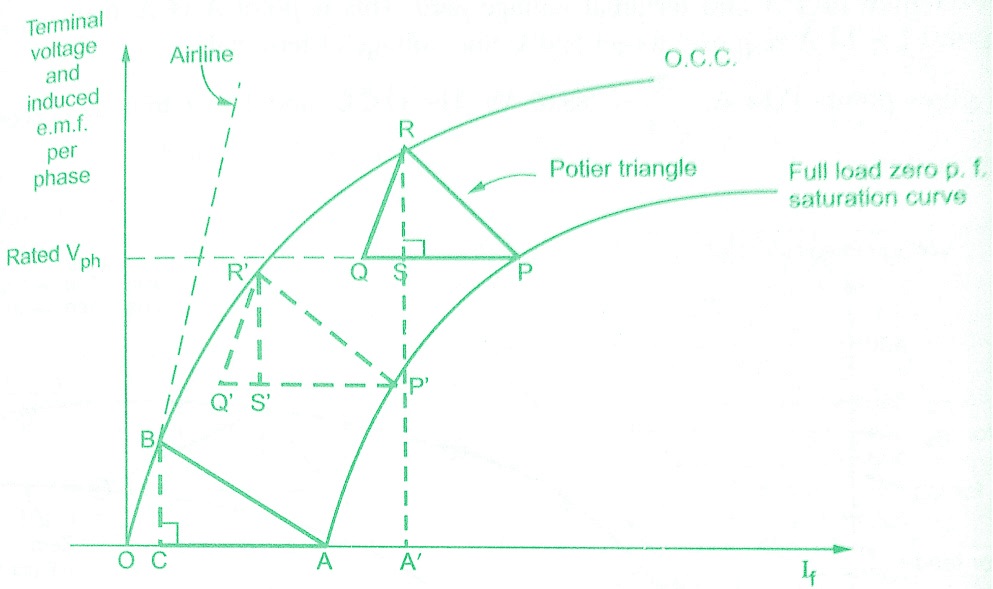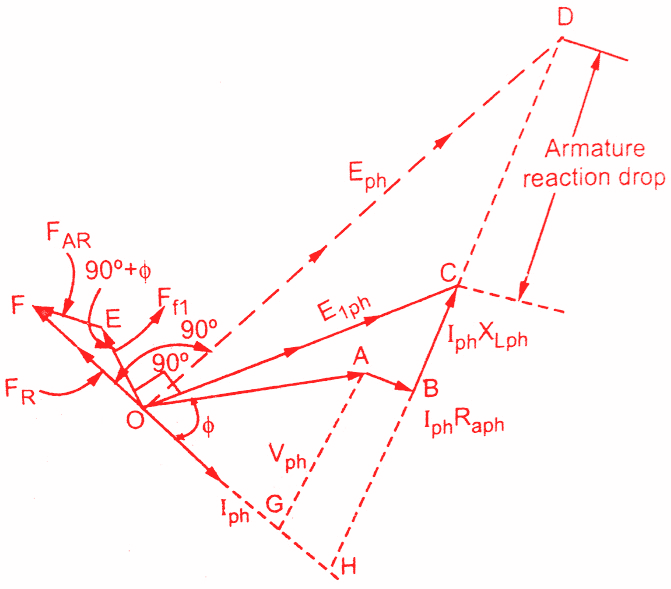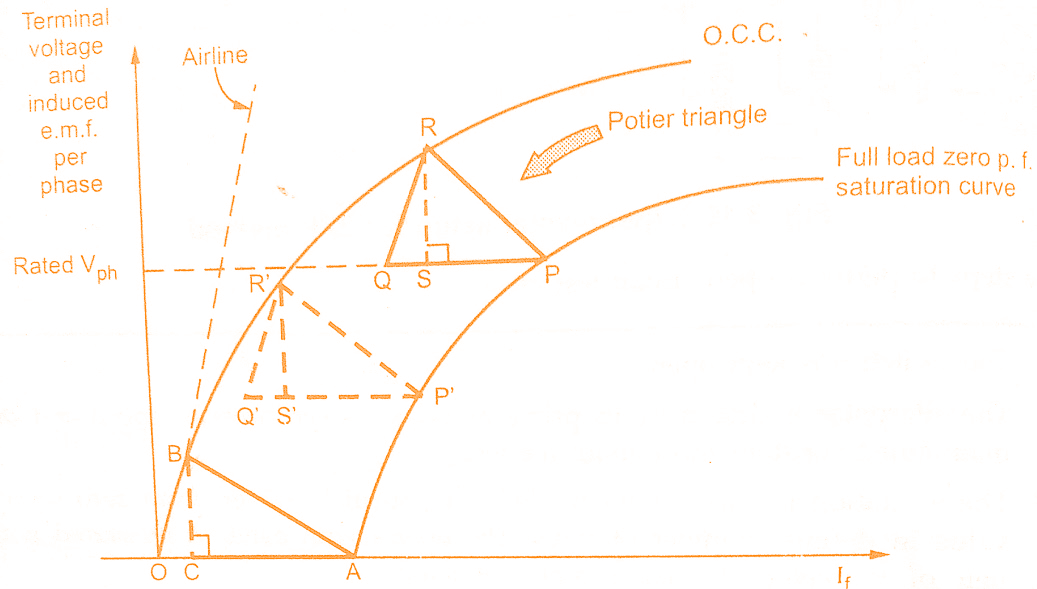Zero Power Factor (ZPF):
This Zero power factor (ZPF) method is used to determine the voltage regulation of synchronous generator or alternator. This method is also called Potier method.
In the operation of an alternator, the armature resistance drop IRa and armature leakage reactance drop IXL are actually emf quantities while the armature reaction is basically MMF quantity. In the synchronous Impedance, all the quantities are treated as EMF quantities as against this in MMF method all are treated as MMF quantities.
Key Point: This zpf method is based on the separation of armature leakage reactance and armature reaction effects. The armature leakage reactance XL is called Potier reactance in this method, hence ZPF method is also called Potier reactance method.
Must Read:
To determine armature leakage reactance and armature reaction MMF separately two tests are performed on the alternator. The two tests are
1. Open circuit test
2. Zero power factor test
1.Open circuit test:
The below is the block diagram to perform open circuit test on the alternator.

Open circuit test is done step by step from the following points,
1. The switch S is opened.
2. The alternator is made to rotate using prime mover at synchronous speed and same speed is maintained constant throughout the test.
3. The excitation value is changed using a potential divider, from zero up to the rated value in a definite number of steps. The open circuit EMF is measured with the help of voltmeter. The readings are tabulated.
4. A graph of If and (Voc)ph i.e. field current and open circuit voltage per phase is plotted to some scale. This is open circuit characteristics.
2.Zero power factor test:
To conduct zero power factor test, the switch S is kept closed. Due to this, a purely inductive load gets connected to an alternator through an ammeter. A purely inductive load has a power factor of cos 90° i.e. zero lagging hence the test is called zero power factor test.
The machine speed is maintained constant at its synchronous value. The load current delivered by an alternator to purely inductive load is maintained constant at its rated full load value by varying excitation and by adjusting variable inductance of the inductive bad. Note that, due to purely inductive load, an alternator will always operate at zero power factor lagging.
Key Point: In this test, there is no need to obtain a number of points to obtain the curve. Only two points are enough to construct a curve called zero power factor saturation curve.
The below is the graph of terminal voltage against excitation when delivering full load zero power factor current. One point for this curve is zero terminal voltage (short circuit condition) and the field current required to deliver full load short circuit armature current.
While other point field current required to obtain rated terminal voltage while delivering rated full load armature current. With the help of these two points, the zero power factor saturation curve can be obtained as
1. Plot open circuit characteristics on a graph paper as shown in the below figure.
2. Plot the excitation corresponding to zero terminal voltage i.e. short circuit full zero power factor armature current. This point is shown as A in the below figure which the x-axis. Another point is the rated voltage when the alternator is delivering full current at zero p.f. lagging. This point is P as shown in the below figure.
3. Draw the tangent to O.C.C. through origin which is line OB as shown dotted in below figure. This is called the airline.
4. Draw the horizontal line PQ parallel and equal to OA.
5. From the point, Q draw the line parallel to the airline which intersects O.C.C. at point R. Join RQ and join PR. The triangle PQR is called Potier triangle.
6. From point R, drop a perpendicular on PQ to meet at point S.
7. The zero power factor full load saturation curve is now be constructed by moving triangle PQR so that R remains always on OCC and line PQ always remains horizontal. The dotted triangle is shown in the above figure. It must be noted that the Potier triangle once obtained is constant for a given armature current and hence can be transferred as it is.
8.Though point A, draw a line parallel to PR meeting OCC at point B. From B, draw a perpendicular on OA to meet it at point C. Triangles OAB and PQR are similar triangles.
9. The perpendicular RS gives the voltage drop due to the armature leakage reactance i.e. IXL
10. The length PS gives field current necessary to overcome the demagnetising effect of armature reaction at full load.
11. The length SQ represents field current required to induce an EMF for balancing leakage reactance drop RS. These values can be obtained from any Potier triangle such as OAB, PQR and so on.
So armature leakage reactance can be obtained as,
This is nothing but the Potier reactance.
Use of Potier reactance to determine regulation of alternator:
To determine regulation using Potier reactance, draw the phasor diagram using the following procedure:
1. Draw the rated terminal voltage Vph as a reference phasor. Depending upon at which power factor (cos Φ) the regulation is to be predicted, draw the Current phasor Iph lagging or leading Vph by angle Φ.
2. Draw Iph Raph voltage drop to Vph which is in phase with Iph. While the voltage drop Iph XLph is to be drawn perpendicular to Iph Raph, vector but leading Iph Raph at the extremity of Vph.
3. The Rph is to be measured separately by passing a d.c current and measuring the voltage across armature winding. While XLph is Potier reactance obtained by Potier method.
Phasor sum of Vph rated, Iph Raph and Iph XLph gives the e.m.f. which is say E1ph.
E1ph = Vph +Iph Raph +Iph XLph
4. Obtain the excitation corresponding to E1ph from OCC which is drawn. Let this excitation be Ff1. This is excitation required for inducing EMF which does not consider the effect of armature reaction.
5. The field current required to balance armature reaction can be obtained from Potier triangle method, which is say FAR.
FAR = I (PS) = I (AC) ……..
6. The total excitation required is the vector sum of the Ff1 and FAR. This can be obtained exactly similar to the procedure used in MMF method.
7. Draw vector Ff1 to some scale, leading E1ph by 90°. Add FAR to Ff1 by drawing vector FAR in phase opposition to Iph. The total excitation to be supplied by field is given by FR.
The complete phasor diagram is shown in the below figure:
Once the total excitation is known which is FR, the corresponding induced emf Eph can be obtained from OCC. This Eph lags FR by 90°. The length CD drops due to the armature reaction. Drawing perpendicular from A and B on current phasor meeting at points G and H respectively, we get triangle OHC as right-angle triangle. Hence E1ph can be determined, analytically also. Once Eph is known, the regulation of an alternator can be predicted as,
ZPF method takes into consideration the armature resistance and leakage reactance voltage drops as EMF quantities and the effect of armature reaction as MMF quantity. This is the reality hence the results obtained by this method are nearer to the reality the those obtained by synchronous impedance method and ampere-turns method. The only drawback of the ZPF method is that the separate curve for every load condition is necessary to plot if Potier triangles for various load conditions are required.
Assumptions Made in the Potier Method:
Some assumptions are made in the Potier method which is listed below
1.ln the entire calculation procedure of Potier method, the armature resistance is neglected. But practically armature resistance is very small and hence this assumption does not cause significant error in the accuracy.
2. In Potier method, a zero power factor test is required to be done. But practically when inductors are used, a perfect zero power factor cannot be achieved.
3. Consider the graphical interpretation of Potier method shown in the below figure.
In this graph, the distances RS, R’ S’ and BC are assumed equal. This represents the voltage drop across the leakage reactance which is (Iaph)FL * XLph.This indicates that the point P in the zero power factor method and point A in the short circuit test represent the same leakage reactance of the machine. But this is not true as the excitation under short circuit condition is OA while that for point P is OA as shown.
Now the excitation OA’ is much higher than OC and hence point P corresponding to saturated conditions represents larger leakage flux which in the method assumed unchanged. Hence practically the leakage reactance corresponding to saturated conditions is higher than that assumed in the method. This introduces the error in the calculations.
Conclusion:
Now today we have learnt Zero power factor(ZPF) or Potier triangle method for regulation of an alternator. You can download this article as pdf, ppt.
Comment below for any Queries.






Thank you for sharing this information. There are several best manufacturer of permanent magnet alternator. However, the one that provides the best services is “J.D. Engineering Works.”
Really useful bro